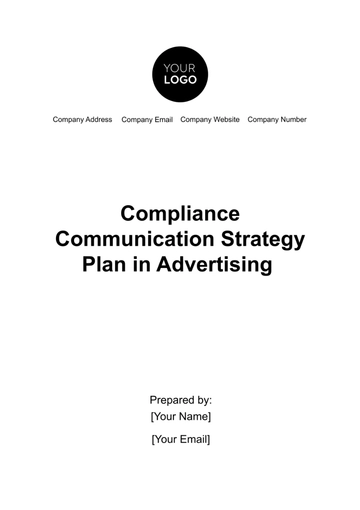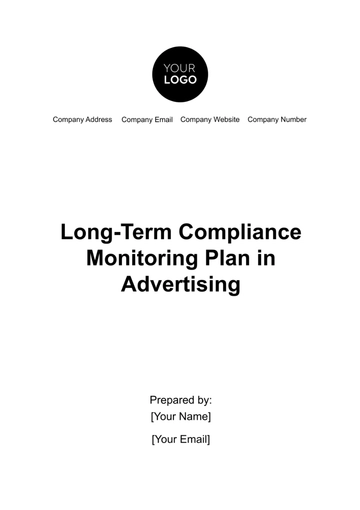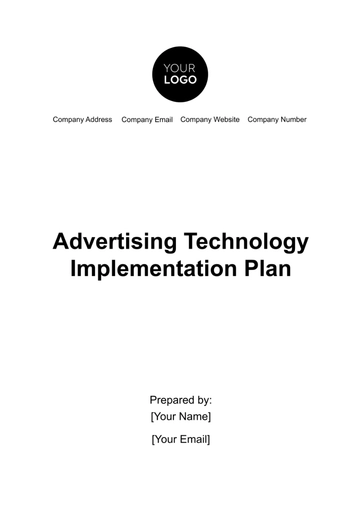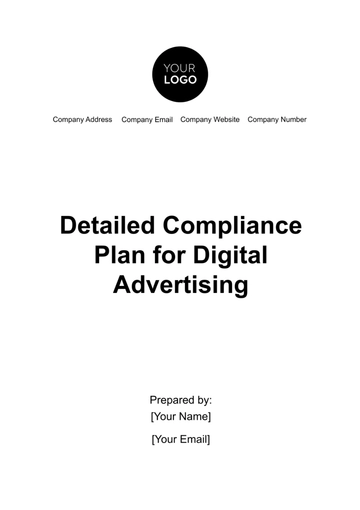Free Advertising Digital Campaign Crisis Response Plan

Introduction
This Crisis Response Plan is a blueprint designed to guide [Your Company Name] through potential crises that may impact our digital advertising campaigns. Recognizing the volatile nature of digital media and the importance of maintaining a positive brand image, this plan prioritizes swift, effective responses to protect both our client relationships and our company's reputation. It encompasses a broad spectrum of scenarios, ranging from technical disruptions to public relations challenges, ensuring that the company is prepared to handle crises with professionalism and efficiency.
Understanding the Digital Landscape
In today's fast-paced digital environment, the landscape of advertising is constantly evolving. We acknowledge that digital campaigns are uniquely susceptible to various challenges, including rapid shifts in consumer sentiment, technological glitches, and cybersecurity threats. By maintaining a proactive stance and utilizing cutting-edge tools for monitoring and analysis, [Your Company Name] is equipped to anticipate potential issues before they escalate into a full-blown crisis.
Crisis Identification and Assessment
In this critical phase, [Your Company Name] employs a robust system to identify and assess potential crises that could impact our digital campaigns. This system is designed to be dynamic, adapting to the ever-changing digital marketing landscape, and is supported by a blend of advanced analytics, real-time monitoring, and expert insights.
Crisis Types and Indicators:
Crisis Type | Indicators | Severity Level | Probability |
Data Breach | Unusual data traffic, security alerts, unauthorized access | High | Moderate |
Campaign Misinformation | Sudden spike in negative feedback, misinformation trends on social media | Medium | Low |
Technical Failure | System downtime, errors in campaign deployment, malfunctioning analytics | High | Moderate |
Legal Issues | Non-compliance alerts, legal notices, policy changes | High | Low |
Preemptive Measures
Data Breach: The company will implement an extensive cybersecurity training program for all employees, emphasizing the importance of data security and best practices. In addition to this, advanced intrusion detection systems are employed, providing real-time monitoring and immediate alerts of any suspicious activities.
Campaign Misinformation: We will enforce fact-checking protocols, ensuring all campaign content is verified for accuracy. Active social media monitoring is conducted using sophisticated tools that can detect and flag potential misinformation. A dedicated team is tasked with continuously scanning the digital landscape for false narratives, enabling prompt corrective action.
Technical Failure: In anticipation of technical failures, the company will maintain redundant systems to ensure the continuous operation of digital campaigns. These include backup servers and alternative hosting solutions. Frequent software updates and routine checks are conducted to maintain system integrity. Additionally, a disaster recovery plan is in place to facilitate quick restoration of services in the event of major technical disruptions.
Legal Issues: We will be regularly updating its legal protocols to stay aligned with the latest regulations and compliance requirements. Compliance audits are periodically conducted to ensure adherence to all legal standards. Additionally, the company maintains ongoing consultations with legal advisors to preemptively address any potential legal challenges.
Rapid Assessment Protocol
Upon identifying a potential crisis, [Your Company Name] activates a rapid assessment protocol. This protocol involves a cross-functional team that quickly evaluates the severity, scope, and potential impact of the crisis. Utilizing a combination of automated tools and expert judgment, this team can provide a swift and accurate assessment, forming the basis for our immediate response strategy.
Response Team
The Response Team at [Your Company Name] is a specialized group of professionals, each with distinct roles and responsibilities, geared towards effectively managing and mitigating any crisis that impacts our digital campaigns.
Team Composition:
Role | Member | Contact Number | Contact Email |
Crisis Manager | [John Smith] | [555 7777 | [@email.com |
PR Lead | |||
IT Security Head | |||
Legal Advisor |
Responsibilities
Crisis Manager: Oversees the entire crisis response process, makes critical decisions, coordinates between different departments, and ensures swift and effective implementation of the crisis plan.
PR Lead: Responsible for all external communications, including crafting and disseminating public statements, managing media relations, and monitoring public sentiment throughout the crisis.
IT Security Head: Leads the technical response to crises involving digital security, such as data breaches or system failures. Oversees the implementation of security measures and coordinates with external cybersecurity experts if needed.
Legal Advisor: Provides legal guidance during crises, especially those involving compliance issues, legal threats, or contractual complications. Ensures all crisis response actions are legally sound.
Team Coordination and Communication
Each member of the Response Team is equipped with advanced communication tools to ensure seamless coordination during a crisis. Regular training sessions are conducted to simulate various crisis scenarios, ensuring that each team member is prepared to act promptly and efficiently. The team also has access to a central crisis management dashboard, which provides real-time updates and facilitates quick decision-making.
Communication Protocol
Effective communication is crucial in crisis management. [Your Company Name] has established a detailed communication protocol to ensure clear, timely, and accurate information flow both internally and externally during a crisis.
1. Internal Communication:
a. Immediate Response: Upon identification of a crisis, an alert is sent to all relevant parties via a secure, dedicated crisis communication channel. This includes the Response Team, senior management, and other pertinent departments.
b. Regular Updates: The Crisis Manager provides regular updates on the status of the crisis, actions taken, and any required support from different departments. These updates are disseminated through internal newsletters, intranet postings, and virtual meetings.
c. Feedback Loop: A system is in place for employees to report any relevant information or concerns, allowing for a two-way communication flow. This ensures that all voices are heard and any additional insights are considered.
2. External Communication:
a. Initial Statement: The PR Lead is responsible for drafting and releasing an initial public statement within 2 hours of crisis confirmation. This statement aims to acknowledge the issue, express commitment to resolution, and provide contact information for further inquiries.
b. Ongoing Updates: Regular updates are provided to the public and stakeholders through various channels including social media, the company website, and press releases. The frequency and content of these updates are tailored to the nature and severity of the crisis.
c. Media Relations: A dedicated team manages all interactions with the media, ensuring consistent and accurate messaging. Media training is provided to all spokespersons to handle interviews and press conferences effectively.
d. Customer Communication: Direct communication channels are established with clients and customers impacted by the crisis. Personalized emails, dedicated support lines, and FAQ sections on the website are used to address their concerns and provide updates.
Monitoring and Evaluation
Throughout the crisis, the company will continuously monitor the effectiveness of its communication strategies. This includes analyzing public sentiment, media coverage, and the response from stakeholders. Post-crisis, a thorough evaluation is conducted to assess the communication impact and identify areas for improvement.
Action Plan
The Action Plan is a critical component of this crisis management strategy. It outlines specific, tailored actions for different types of crises, ensuring a rapid and effective response to mitigate impact.
1. Detailed Crisis Response Strategies:
1. Data Breach
a. Immediate Action: Immediate isolation of affected systems. Notify IT security and initiate a forensic investigation to determine the source and extent of the breach.
b. Short-term Measures: Notify affected stakeholders and implement temporary protective measures. Enhance system security protocols to prevent further incidents.
c. Long-term Mitigation: Conduct a comprehensive review of cybersecurity policies. Implement advanced security technologies and conduct regular training for all employees to prevent future breaches.
2. Campaign Misinformation
a. Immediate Action: Instantly pause affected campaigns. Initiate an investigation to identify the source of misinformation. Release an official statement to counteract false narratives.
b. Short-term Measures: Monitor public sentiment and engage in proactive communication to restore brand reputation. Review and revise content verification processes.
c. Long-term Mitigation: Develop and implement a robust digital monitoring system to quickly identify and address misinformation. Enhance team training in media literacy and crisis communication.
3. Technical Failure
a. Immediate Action: Activate backup systems to minimize service disruption. Identify and diagnose the cause of the failure. Inform stakeholders about the issue and expected resolution time.
b. Short-term Measures: Conduct a thorough analysis to understand the failure's root cause. Implement interim solutions to stabilize operations.
c. Long-term Mitigation: Upgrade or replace faulty systems. Establish regular maintenance schedules and conduct periodic stress tests to ensure system resilience.
4. Legal Issues
a. Immediate Action: Consult with the legal team and temporarily halt any potentially non-compliant campaigns. Assess the legal implications and plan an appropriate response.
b. Short-term Measures: Communicate with legal authorities and stakeholders to clarify and resolve issues. Adjust campaign strategies to comply with legal requirements.
c. Long-term Mitigation: Regularly update legal knowledge and compliance protocols. Train staff on legal compliance and ethical advertising practices. Introduce regular legal audits to ensure ongoing adherence to laws and regulations.
Coordination and Implementation
Each action step in our crisis response is coordinated meticulously. The Crisis Manager oversees the implementation of these actions, ensuring alignment with the overall crisis management strategy. Regular debriefings are held to update all stakeholders on progress and adapt the strategy as the situation evolves.
Post-Crisis Analysis and Adaptation:
After the resolution of a crisis, the company conducts a thorough analysis to evaluate the effectiveness of the response. Lessons learned are integrated into future planning, ensuring continuous improvement in our crisis management capabilities.
Monitoring and Review
The effectiveness of [Your Company Name]'s crisis response is continuously monitored and reviewed to ensure the highest standards of crisis management are maintained.
1. Ongoing Crisis Monitoring:
a. Real-Time Monitoring: The company utilizes a suite of advanced monitoring tools that provide real-time insights during a crisis. These tools encompass a broad range of analytics, including:
i. Social Media Sentiment Analysis: Leveraging AI-powered sentiment analysis tools to gauge public perception and response across various social platforms.
ii. Media Coverage Tracking: Utilizing media monitoring software to track and analyze coverage across digital, print, and broadcast media, ensuring a 360-degree view of the crisis's public impact.
b. Performance Metrics: To quantitatively assess the crisis response, the company has set specific KPIs for each type of crisis. These KPIs are meticulously designed to measure the efficiency and effectiveness of our response, including:
2. Post-Crisis Review and Learning:
a. Debriefing Sessions: After the resolution of a crisis, comprehensive debriefing sessions are conducted with all involved parties. These sessions aim to identify successes, challenges, and areas for improvement.
b. Report Compilation: A detailed report is compiled, documenting the crisis timeline, actions taken, outcomes, and recommendations for future crisis management strategies.
c. Continuous Improvement: Insights gained from each crisis are used to refine and improve our Crisis Response Plan, ensuring ongoing development and preparedness.
Conclusion
The Crisis Response Plan for [Your Company Name] is a testament to our commitment to proactive risk management and excellence in digital campaign management. This plan is a living document that evolves with the dynamic digital landscape and our growing experience. By implementing this plan, our company can guarantee that we are always prepared to respond effectively to any crisis, safeguarding our clients' interests and our company's reputation. Our dedication to continuous improvement in crisis management is integral to our mission of delivering exceptional advertising services in an ever-changing digital world.
- 100% Customizable, free editor
- Access 1 Million+ Templates, photo’s & graphics
- Download or share as a template
- Click and replace photos, graphics, text, backgrounds
- Resize, crop, AI write & more
- Access advanced editor
Craft effective crisis response strategies for digital campaigns with Template.net's Advertising Digital Campaign Crisis Response Plan Template. This editable and customizable tool offers a structured framework for anticipating and addressing potential crises swiftly. Utilize our intuitive Ai Editor Tool to tailor the plan to your campaign's unique requirements effortlessly, ensuring a proactive approach to crisis management.
You may also like
- Finance Plan
- Construction Plan
- Sales Plan
- Development Plan
- Career Plan
- Budget Plan
- HR Plan
- Education Plan
- Transition Plan
- Work Plan
- Training Plan
- Communication Plan
- Operation Plan
- Health And Safety Plan
- Strategy Plan
- Professional Development Plan
- Advertising Plan
- Risk Management Plan
- Restaurant Plan
- School Plan
- Nursing Home Patient Care Plan
- Nursing Care Plan
- Plan Event
- Startup Plan
- Social Media Plan
- Staffing Plan
- Annual Plan
- Content Plan
- Payment Plan
- Implementation Plan
- Hotel Plan
- Workout Plan
- Accounting Plan
- Campaign Plan
- Essay Plan
- 30 60 90 Day Plan
- Research Plan
- Recruitment Plan
- 90 Day Plan
- Quarterly Plan
- Emergency Plan
- 5 Year Plan
- Gym Plan
- Personal Plan
- IT and Software Plan
- Treatment Plan
- Real Estate Plan
- Law Firm Plan
- Healthcare Plan
- Improvement Plan
- Media Plan
- 5 Year Business Plan
- Learning Plan
- Marketing Campaign Plan
- Travel Agency Plan
- Cleaning Services Plan
- Interior Design Plan
- Performance Plan
- PR Plan
- Birth Plan
- Life Plan
- SEO Plan
- Disaster Recovery Plan
- Continuity Plan
- Launch Plan
- Legal Plan
- Behavior Plan
- Performance Improvement Plan
- Salon Plan
- Security Plan
- Security Management Plan
- Employee Development Plan
- Quality Plan
- Service Improvement Plan
- Growth Plan
- Incident Response Plan
- Basketball Plan
- Emergency Action Plan
- Product Launch Plan
- Spa Plan
- Employee Training Plan
- Data Analysis Plan
- Employee Action Plan
- Territory Plan
- Audit Plan
- Classroom Plan
- Activity Plan
- Parenting Plan
- Care Plan
- Project Execution Plan
- Exercise Plan
- Internship Plan
- Software Development Plan
- Continuous Improvement Plan
- Leave Plan
- 90 Day Sales Plan
- Advertising Agency Plan
- Employee Transition Plan
- Smart Action Plan
- Workplace Safety Plan
- Behavior Change Plan
- Contingency Plan
- Continuity of Operations Plan
- Health Plan
- Quality Control Plan
- Self Plan
- Sports Development Plan
- Change Management Plan
- Ecommerce Plan
- Personal Financial Plan
- Process Improvement Plan
- 30-60-90 Day Sales Plan
- Crisis Management Plan
- Engagement Plan
- Execution Plan
- Pandemic Plan
- Quality Assurance Plan
- Service Continuity Plan
- Agile Project Plan
- Fundraising Plan
- Job Transition Plan
- Asset Maintenance Plan
- Maintenance Plan
- Software Test Plan
- Staff Training and Development Plan
- 3 Year Plan
- Brand Activation Plan
- Release Plan
- Resource Plan
- Risk Mitigation Plan
- Teacher Plan
- 30 60 90 Day Plan for New Manager
- Food Safety Plan
- Food Truck Plan
- Hiring Plan
- Quality Management Plan
- Wellness Plan
- Behavior Intervention Plan
- Bonus Plan
- Investment Plan
- Maternity Leave Plan
- Pandemic Response Plan
- Succession Planning
- Coaching Plan
- Configuration Management Plan
- Remote Work Plan
- Self Care Plan
- Teaching Plan
- 100-Day Plan
- HACCP Plan
- Student Plan
- Sustainability Plan
- 30 60 90 Day Plan for Interview
- Access Plan
- Site Specific Safety Plan





























